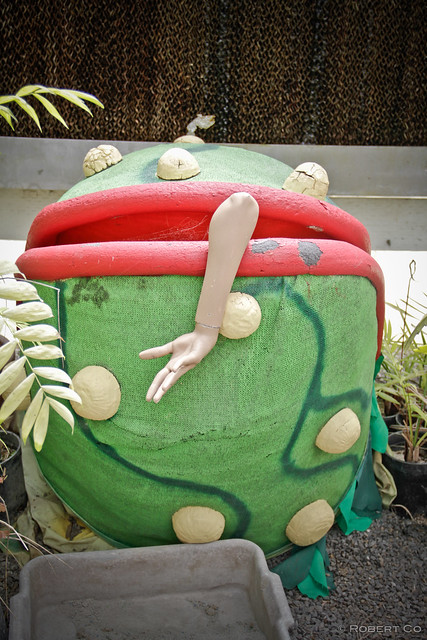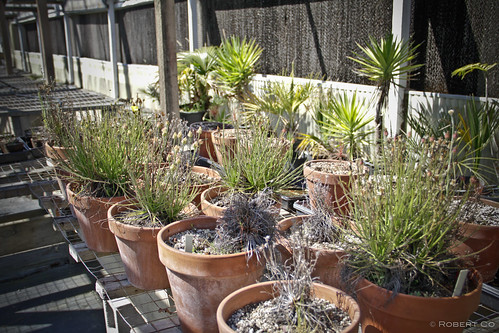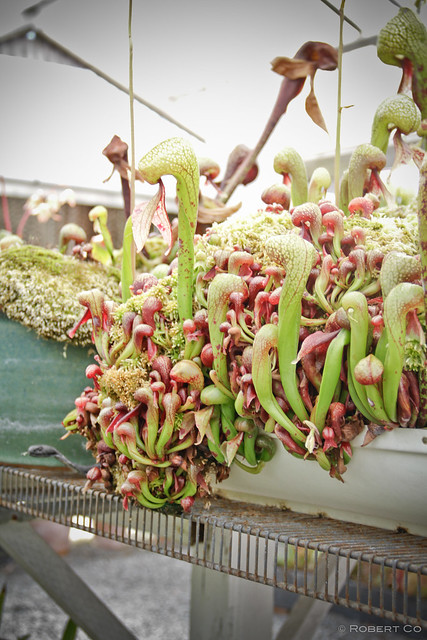
You may of remembered that at beginning of this month, I was covering quite a few things up. Now, I’m finding myself laying it all out on the table. Well, tables. This last weekend, Dahlia and I spent the day doing some trimming, pulling the weeds out of the pots, and finally – getting the plants out to the tables. In the photo to the left, you can see a few of the tables covered up, finally. I’ve had the plants just bumbling along in their cement mixing tubs and other trays packed in somewhat tight (to save space.) This is great for moving and saving space. But now, I’m sure that the plants are happy to be moving from cramped quarters onto the water tables. The way they’re packed now leaves them desiring some room for improvement. Literally. See, although it’s brighter now, the plants aren’t getting all the light or air circulation that they could be getting since they’re packed close. Don’t get me wrong though! I’m in an area that’s much better – and now that the plants are getting spread out, they’ll really get hit with the light and air that they desire. What I’m hoping for is that the elongated foliage they developed at the old place would really be put to use now – acting as larger solar panels (for lack of better illustration) and absorb even more light to store in the rhizome for next season. Also, insects do find their way in because of the vents, so that’s more food for them! It isn’t pretty just yet, but next year should be quite a show. (I’m putting this down in this blog entry so that by the time next season comes around – I can test my theory out and see if my hypothesis is right.)
In the meantime, enjoy a few photos of the work in progress below! It’s not pretty as you’ll notice the long and stretched leaves that the plants produced. I was really tempted to cut most of those leaves off for aesthetic reasons/personal taste, but I know that the plants would benefit better if I left the foliage. Like I mentioned before — I’m hoping that those long leaves will be put to good use so I’m keeping a majority of them connected to the plant still. Also, I won’t be dividing them just yet as I’d hate to disturb/shock them after all the crap they went through this year. I plan on doing some divisions later in the late fall/winter.
***

After moving a few plants to the tables, the place really started to look like a nursery! It is truly a joy to see things come this far. That’s Dahlia in the back helping me weed/clean the plants. I grouped the plants together by genus/species/subspecies/variations as well. One of the things I’d like to do in the coming seasons is concentrate more on species and populations from different locations. Doing all of this hybridizing work really makes me appreciate the species so much more and makes me realize that keeping the genetic bloodlines is truly important.
I had species mixed up all over the place before. Now that I have room, it’s good to have things together. Another project in the future that I have in mind will be to do a census. I no longer keep a growlist as there have been too many changes in a short amount of time to even try to keep up with things. Freakin’ intense…

Above I’ve placed all Pinguicula, Dionaea, Drosera, Utricularia, and Darlingtonia together. I’ll be going through and dividing/propagating later, so keep checking back as I’ll make things available every now and then. And yeah, sorry for not updating the shop as often as I should, but — once things settle down and get organized, I hope to change that!

Sarracenia purpureas, psittacinas, and minors all together in this section. In the distance, you can see how friggin beat up the minors are from being in the low light conditions. Behind that are the leucophyllas.

Here’s a shot of the grouping of minors. So SAD! UGH! They are so beat up! The older traps are weak, elongated, and floppy. However, check out a few of the new traps as you can see those are strong and upright.

Here we have the grouping of Sarracenia rubra, and in the back is the Sarracenia leucophylla section. I’m keeping the rubras on the higher end/dryish part of the table. Fellow Sarracenia-phile Mike Wang suggests that S. rubras like things on the dryer side. I’ve been top watering and letting the excess run down to the rest of the table where the S. leucophyllas are sitting. Uneven tables: I guess that’s a good thing for situations like this.
Sarracenia leucophyllas are making a come back! S. leucophyllas throw pitchers up in the fall anyway – this is their time to shine! It’s nice to see them recovering and looking much happier now!

In this front section of this table are all of the S. ‘Reptilian Rose’ hybrids/seedlings that were created by Dr. Travis H. Wyman. I’m really spacing these out to get as much light and air to the plants as possible. I have great hopes for these babies, and I’m sure Dr. Wyman does too. In the back section are various other hybrids of similar shape/form all mixed in.

Another angle of the Sarracenia ‘Reptilian Rose’ hybrid section. You can see the old lanky growth vs. the stronger upright recent growth on some of these plants.

OH MY! The anthocyanin free section. OF COURSE! Y’all should know me by now. I am an anthocyanin free addict!

Here’s a few of the Sarracenia courtii AF x “Green Monster” crosses I did from 2009. They are on the road to recovery!

The field of screams! The Dionaea group. They’ve really turned around since the move into The Asylum.
Hope you enjoyed this quick update – will be working on putting the rest of the tables together and moving plants over the course of the next few weeks. Good times indeed!









 Sarracenia “Pink Eye”
Sarracenia “Pink Eye”



























